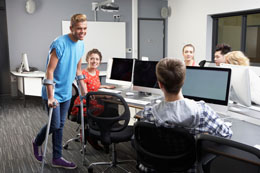Pain, weakness or deformity constitute the major causes of limping in children. Various diseases and disorders can affect the movement of the leg, resulting in limping. Read on to know what causes it.

An unnatural, jerky or laborious gait is referred to as limp. Watching the child limping is a heart breaking situation for the parents. Overactive children often get injured during vigorous sports activities. Children engaged in sports activities, cycling, swimming, trekking, etc. often return home with leg injuries, fractures or suffer from weak muscles and cramps. Some causes of limping in children are negligible but some are serious and need prompt medical attention. Take a look at the following list of causes of claudication or disability of walking.
Causes of Claudication in Children
A child with walking disability may exhibit symptoms like crippling of the legs or feet; difficulty standing or walking; restricted movement of the legs; calf, foot, thigh or knee pain; swelling, inflammation in the foot or various joints like hip joint, ankle; bruising and bleeding.
Common causes of limping in children include:
- Injuries, puncture wounds, stress fractures, lacerations while playing, cycling, etc. are very common in children.
- Peroneal nerve palsy after a trauma or hereditary motor sensory neuropathy can lead to uneven and jerky gait.
- Musculoskeletal diseases can severely affect the capacity of the back and legs to support the body.
- Brain anoxia (lack of oxygen) and cerebral palsy can lead to spastic gait (toe walking).
- Juvenile arthritis, diabetes can lead to joint pain, joint deformity, peripheral neuropathy, resulting in limping.
- Any problem or disorder of the vertebrae, femur, tarsals, metatarsals can result in limping.
- Blood circulation problems can cause pain or numbness in legs.
- Various types of infections, very high fever, degenerative back and spine diseases can result in an uneven gait.
- Congenital structural defects in back, hip, legs, can lead to a limp.
- Serious diseases like leukemia, bone cancer can induce limping in children.
- Hip dysplasia, congenital hypotonia, are some of the causes of difficulty in leg movement in children.
- Obesity makes the bones and muscles weak, increasing the chances of injuries.
- Nutritional deficiencies, wrong postures can affect the gait.
- Tears of the meniscus, weakness after surgeries, dislocated joints can lead to limping.
- Use of ill-fitting shoes, not using protective pads, knee caps, etc. while playing can result in injuries.
- Bursitis, tendonitis, bone spurs, corns and calluses, gout can lead to knee or foot pain.
- Neurosyphilis or spinal column space-occupying lesions can be the cause of slapping gait and lack of proprioception.
- Along with fractures, abuse injuries, sprains, slipped disk and avascular necrosis (death of the tissue) can lead to limping in children.
- Systemic lupus erythematosus, other autoimmune diseases, Baker's cyst, injury to collateral and cruciate ligaments, torn ligaments can lead to knee pain and limping.
- Transient synovitis, septic arthritis, osteomyelitis (inflammation of bone and bone marrow due to bacterial infection) are some of the common causes of limping in toddlers.
Limping in Children: Prevention and Treatment
Medical history, physical examination and various tests like X-ray, MRI help find out the exact cause of limping. The treatment varies according to the cause. But some of the causes can be eliminated by using proper shoes and accessories while playing and by following the instructions of the trainer. Sports injuries, bone fractures, and foot pain in children are quite common. Children should take sufficient rest after the injury or surgery. Proper warm-up exercises, regular exercises, can tone the muscles and help prevent frequent injuries. Trainers should not insist on playing, ignoring the injuries. Massage therapy is helpful in gaining the strength of the muscles. A healthy diet is essential for proper functioning of the body systems. Lack of nutrients can weaken the bones and muscles; which can increase the chances of fractures and injuries.
A healthy diet and regular exercises play an important role in strengthening the legs and all body systems. A strong immune system helps prevent dangerous diseases. Use of proper equipment can help avoid injuries and fractures while physiotherapy can help move the legs properly. With correct diagnosis and prompt treatment, a limping child can walk normally.


 An unnatural, jerky or laborious gait is referred to as limp. Watching the child limping is a heart breaking situation for the parents. Overactive children often get injured during vigorous sports activities. Children engaged in sports activities, cycling, swimming, trekking, etc. often return home with leg injuries, fractures or suffer from weak muscles and cramps. Some causes of limping in children are negligible but some are serious and need prompt medical attention. Take a look at the following list of causes of claudication or disability of walking.
An unnatural, jerky or laborious gait is referred to as limp. Watching the child limping is a heart breaking situation for the parents. Overactive children often get injured during vigorous sports activities. Children engaged in sports activities, cycling, swimming, trekking, etc. often return home with leg injuries, fractures or suffer from weak muscles and cramps. Some causes of limping in children are negligible but some are serious and need prompt medical attention. Take a look at the following list of causes of claudication or disability of walking.